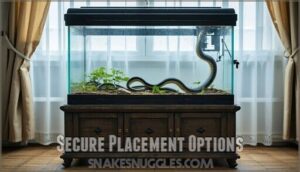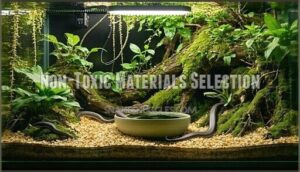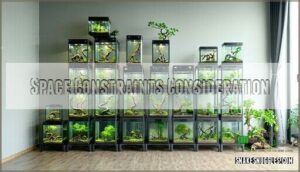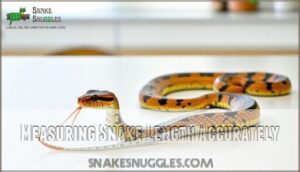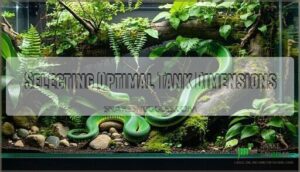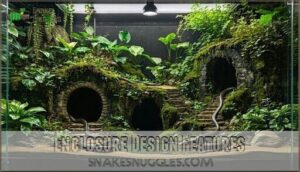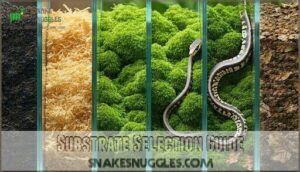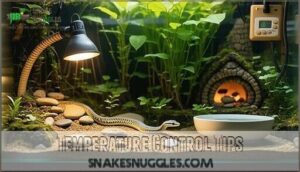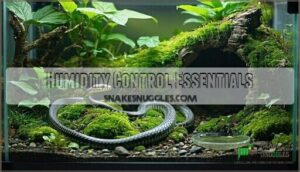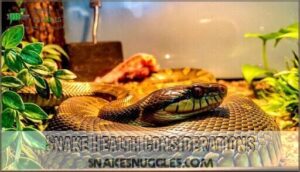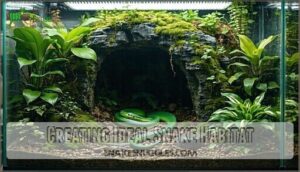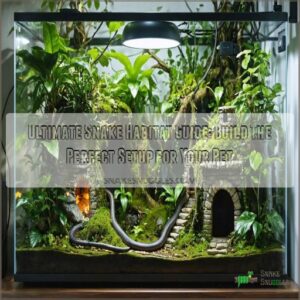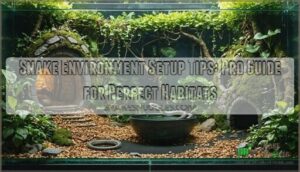This site is supported by our readers. We may earn a commission, at no cost to you, if you purchase through links.
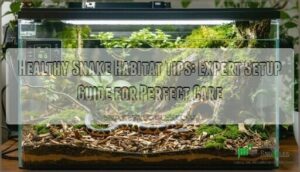
You’ll need secure locks since snakes are escape artists who’d make Houdini jealous.
Select non-toxic substrates like cypress mulch or paper towels, avoiding cedar or pine shavings that can cause respiratory issues.
Establish temperature gradients with under-tank heaters, maintaining basking spots around 88-92°F and cool sides at 78-82°F.
Monitor humidity levels between 50-60% for most species, using digital hygrometers for accuracy.
Provide hiding spots on both warm and cool sides—stressed snakes don’t eat well.
The devil’s in the details regarding substrate choices and heating methods, which are crucial for creating a healthy environment, with secure locks and temperature gradients being essential, and remembering that snakes are escape artists, and they need hiding spots.
Table Of Contents
- Key Takeaways
- Choosing Enclosure Type
- Enclosure Size Selection
- Enclosure Design Features
- Substrate Selection Guide
- Temperature Control Tips
- Humidity Control Essentials
- Snake Health Considerations
- Creating Ideal Snake Habitat
- Frequently Asked Questions (FAQs)
- How do I choose a snake habitat?
- How do you keep a snake healthy?
- How do I create a safe home for my scaly snake?
- What makes a good environment for a snake?
- How do you care for a scaly snake?
- How do you care for a snake’s enclosure?
- How to keep your snake healthy?
- What not to put in a snake enclosure?
- How to make sure your snake is happy?
- How to take good care of a snake?
- Conclusion
Key Takeaways
- Choose the right enclosure with secure locks – You’ll want glass for visibility or PVC for better humidity control, but always prioritize escape-proof lids with robust locking mechanisms since snakes are notorious escape artists.
- Create proper temperature gradients using under-tank heaters – You need a basking spot at 88-92°F and a cool side at 78-82°F, using thermostats to prevent burns and allowing your snake to regulate its body temperature naturally.
- Select safe substrates and avoid toxic materials – You should use aspen shavings or cypress mulch while avoiding cedar or pine shavings that can cause respiratory problems and impaction risks.
- Maintain humidity levels between 50-60% with hiding spots on both sides – You’ll need digital hygrometers for accurate monitoring and humidity hides to prevent shedding issues while providing security that reduces stress and promotes healthy behavior.
Choosing Enclosure Type
You’ll want to prioritize security and safety when selecting your snake’s enclosure, focusing on escape-proof designs with proper ventilation and non-toxic materials.
The right placement away from high-traffic areas and temperature fluctuations will keep your snake comfortable while making maintenance easier for you, emphasizing the importance of safety.
Secure Placement Options
Position your snake enclosure on stable furniture away from windows, high-traffic areas, and noisy appliances.
This prevents vibration and stress while ensuring consistent temperatures. Choose reinforced stands supporting triple the weight for safety.
Install robust locking mechanisms on secure, escape-proof lids with tight mesh.
Single-species housing reduces competition and disease transmission, creating the ideal snake habitat.
Non-Toxic Materials Selection
Your snake’s safety depends on choosing the right materials from the start. Glass terrariums and PVC enclosures offer non-toxic environments, while aquarium-grade silicone guarantees secure, safe joints.
Start with the right materials – your snake’s life depends on it.
Essential safe materials include:
- Safe substrates like aspen shavings and coconut fiber
- Toxin-free cleaning products designed for reptile habitats
- Food-grade water bowls made from ceramic or stainless steel
- Natural decor options like untreated wood and live plants for bioactive setups
Selecting the correct bedding involves choosing safe snake substrate for peak health.
Space Constraints Consideration
When you’re dealing with limited space, smart planning makes all the difference.
Consider your room’s layout and available floor space before committing to a snake habitat.
Stackable enclosures and repurposed furniture can maximize vertical space efficiently.
| Space Challenge | Creative Solutions |
|---|---|
| Small apartments | Wall-mounted shelving systems |
| Limited floor space | Stackable enclosures with proper ventilation |
| Budget constraints | Repurposed furniture as stands |
| Multiple snakes | Modular rack systems |
| Rental restrictions | Minimalist design with portable setups |
Remember that adult size planning trumps current convenience – your snake’s growth space needs matter more than saving a few square feet today.
Enclosure Size Selection
You’ll need to select the right tank size before bringing your snake home, as cramped quarters can stunt growth and create stress.
Getting the measurements wrong from the start means you’ll face costly upgrades later when your pet outgrows its space, which can lead to costly upgrades.
Measuring Snake Length Accurately
Accurate measurement forms the foundation of proper snake habitat setup. You’ll need a flexible tape measure to trace your snake’s spine while it’s relaxed and fully stretched out.
Here’s how to measure effectively:
- Use a flexible tape measure along the snake’s spine from snout to tail tip
- Wait until your snake is completely relaxed and stretched out naturally
- Take multiple measurements during different sessions for consistency
- Record measurements frequently during growth phases for young snakes
- Consider using digital tools or marked objects in photos for difficult-to-handle snakes
Regular measurement frequency guarantees your adult size planning stays on track as your snake grows. Providing the largest cage possible is vital for their well-being. Accurate and regular measurement is key to ensuring you can provide the best environment for your snake, and proper snake habitat setup is essential for their health.
Accounting for Growth Space Needs
Planning your snake’s future enclosure prevents cramped conditions that cause stunted growth. Young snakes outgrow tanks quickly, so always buy for adult size, not current length.
A ball python enclosure size can help determine appropriate dimensions. This smart space utilization saves money on habitat expansion later.
| Growth Stage | Tank Size | Snake Length | Timeline |
|---|---|---|---|
| Hatchling | 10-20 gallon | 6-12 inches | 0-6 months |
| Juvenile | 20-40 gallon | 1-3 feet | 6-18 months |
| Young Adult | 40-75 gallon | 3-4 feet | 18-36 months |
| Full Adult | 75+ gallon | 4-6 feet | 3+ years |
| Large Species | Custom/Room | 6+ feet | Varies |
Selecting Optimal Tank Dimensions
Your tank’s dimensions directly impact your snake’s quality of life.
Use this formula: length equals your snake’s adult size, width and height should be at least half that measurement.
A 4-foot corn snake needs a 4x2x2-foot enclosure minimum.
Tank shape matters too—horizontal designs suit terrestrial species, while vertical tanks benefit climbers.
Prioritize space utilization over cramped quarters.
Enclosure Design Features
Your snake’s enclosure design directly impacts their health, behavior, and overall well-being.
Smart design choices create a secure, enriching environment that meets your snake’s natural instincts while preventing escapes and stress.
Providing Enrichment Features Naturally
Your snake deserves more than four walls and a water bowl.
Natural enrichment transforms basic enclosures into engaging environments that promote physical and mental wellbeing.
- Natural Climbing structures like cork bark and driftwood encourage exercise
- Burrowing Options using deeper substrate layers satisfy digging instincts
- Foraging Opportunities through hidden feeding spots stimulate natural hunting behaviors
- Varied Textures from smooth rocks to rough branches provide Sensory Stimulation
Vertical Vs Horizontal Tanks
Your snake’s natural behavior determines whether you need height or length in your enclosure.
Arboreal species like green tree pythons require vertical space for climbing opportunities, while terrestrial snakes such as ball pythons need horizontal room to stretch.
Choose enclosure type based on snake activity patterns – climbers get tall tanks, ground-dwellers get long ones for maximum space efficiency.
Escape Proofing Measures
Your snake’s greatest magic trick shouldn’t be disappearing from its home.
Install robust locking mechanisms on secure lids with tight-fitting clamps that won’t budge when pushed. Check mesh integrity regularly—ventilation gaps must be smaller than your snake’s head.
Test lid security weekly, inspecting for damage or loose pieces. A truly escapeproof lid with proper locking mechanisms transforms your enclosure into a secure sanctuary, ensuring your snake stays safely inside where it belongs, providing a sense of security.
Substrate Selection Guide
You’ll need the right substrate foundation for your snake’s health and comfort.
Choose carefully from safe options while avoiding materials that can harm your pet’s respiratory system or cause dangerous blockages.
Safe Substrate Options for Snakes
You’ll find several excellent safe substrate options for your snake habitat.
Aspen shavings benefits include superior absorbency and easy spot cleaning, making maintenance simple.
Coconut fiber uses moisture retention effectively for tropical species needing higher humidity levels.
Substrate depth matters substantially—maintain at least three inches for natural burrowing behavior.
Cleaning frequency should involve daily spot removal of waste and complete replacement monthly.
Bioactive substrates create self-sustaining ecosystems with beneficial microorganisms.
However, substrates like cedar shavings harm snake respiratory systems, which is a critical consideration for snake health.
Avoiding Toxic Substrate Materials
Beyond the obvious suspects like rotting wood, certain materials spell disaster for your snake’s health.
Cedar and pine shavings release toxic oils causing respiratory damage, while sand creates impaction risks when ingested.
Cat litter contains harsh chemicals, and walnut shells grow dangerous mold.
Choose safe alternatives like aspen bedding or coconut fiber instead.
For safe options, consider buying aspen bedding for your snake.
Maintaining Substrate Cleanliness Daily
Proper cleaning habits keep your snake’s environment fresh and healthy. Daily waste removal prevents bacterial buildup and creates a safer space for your pet to thrive.
- Spot Cleaning – Remove feces and soiled substrate immediately when spotted
- Waste Removal – Check for urates and food remnants during daily visual inspections
- Mold Prevention – Replace any damp or discolored substrate areas right away
- Odor Reduction – Address smelly spots before they spread throughout the habitat
- Parasite Control – Monitor for unusual debris that might indicate health issues
Complete substrate replacement every 1-3 months maintains ideal habitat maintenance and prevents long-term bacterial buildup in your snake’s home.
To assist in this process, explore the snake substrate cleaner options available.
Temperature Control Tips
You’ll need to keep your snake’s enclosure at just the right temperature, since these reptiles can’t grab a sweater when they’re cold.
Careful temperature control keeps your snake healthy and active, so let’s make sure your setup doesn’t turn into a reptile sauna or an accidental icebox.
Creating Temperature Gradients
Once you’ve picked the right substrate, it’s time to focus on temperature control.
Creating a temperature gradient in your snake habitat lets your pet choose between a cozy basking spot and a cool zone.
Place the heat source on one side, not the middle, and use a thermostat for regular temperature monitoring, guaranteeing gradient importance, supporting healthy digestion and activity.
Using Under Tank Heaters
Once you’ve set up your temperature gradient, undertank heaters (UTHs) step in to provide steady belly heat.
Place your UTH under one-third of the tank, elevate the enclosure for airflow, and always pair it with thermostat control to prevent burns.
Choose wattage based on species needs, and monitor temperatures frequently—your snake habitat’s comfort depends on these heating elements.
Regulating Heat Sources
In regards to snake habitat temperature control, you’ll want to double-check thermostat calibration and heat source placement.
Aim for steady basking spot temperatures, and use thermostats to prevent burns from heat lamps or heating elements.
Nighttime temperature drops mimic nature, but don’t let it get too chilly.
Regular monitoring keeps your snake comfortable, healthy, and out of hot water—literally!
Humidity Control Essentials
You’ll need to keep a close eye on humidity, since your snake’s health depends on the right balance.
If you’ve ever tried to shed a sweater that just won’t budge, you’ll understand why proper moisture and a good humid hide matter so much, especially for good humid hide.
Monitoring Humidity Levels
Using Humidity Sensors and a reliable hygrometer, you’ll keep tabs on humidity levels and dodge common issues like Shedding Problems and poor Respiratory Health.
For hassle-free humidity monitoring, follow these steps:
- Place sensors at both ends.
- Check readings daily.
- Watch for condensation.
- Adjust for Species Needs.
- Trust your snake’s behavior—odd habits may signal hydration levels are off, which can lead to Respiratory Health issues.
Maintaining Optimal Humidity
After monitoring humidity levels, it’s time to keep things steady.
Adjust humidity control daily to match your snake’s species needs—tropical snakes love 60–80%, while arid types need less.
Misting, larger water dishes, and covering part of a screen lid all help.
Keep an eye out for mold prevention and shedding issues.
Here’s a handy cheat sheet:
| Tip | Benefit |
|---|---|
| Daily misting | Hydration levels |
| Warm-side water dish | Humidity boost |
| Cover screen lid | Mold prevention |
| Check hygrometers | Respiratory health |
The provided tips are crucial for maintaining the humidity levels and overall health of your snake, including respiratory health and ensuring proper hydration levels.
Using Humidity Hides
A humidity hide box is your secret weapon for perfect snake humidity control.
Pick the right Moss Selection, keep it just damp, and let your snake self-regulate during shedding.
Optimal humidity levels prevent shedding issues.
Try these tips:
- DIY hides with plastic containers
- Shedding Aid with moist moss
- Location Matters—place near warmth
- Cleaning Frequency—weekly checks
- Supports overall snake habitat humidity levels, which is crucial for perfect snake humidity control and helps in shedding issues prevention.
Snake Health Considerations
You want your snake to stay healthy, so it’s important to watch for common issues like respiratory problems and early signs of illness.
With the right care and a bit of attention—think of it as your snake’s version of a regular checkup—you’ll help prevent problems before they start.
Common Health Issues in Snakes
Spotting common health issues early keeps your snake happy and out of trouble.
Watch for shedding problems, mouth rot, scale rot, parasites, and obesity—these snake diseases can sneak up fast.
Respiratory health matters, so keep your setup clean and conditions stable.
Snake health monitoring is your best defense; a healthy snake is a content companion.
One issue to be aware of is that snakes can develop respiratory infections and pneumonia, requiring prompt veterinary attention.
| Problem | Signs | Solution |
|---|---|---|
| Shedding Issues | Retained skin | Humidity hides |
| Mouth Rot | Mouth mucus | Vet care |
| Scale Rot | Red, damaged | Clean substrate |
| Parasites | Scratching | Deworming |
| Obesity | Lethargy | Adjust feeding |
Recognizing Signs of Illness Early
Your snake’s well-being depends on catching illness early through careful snake health monitoring.
Watch for behavioral changes like lethargy or hiding more than usual, as these often signal trouble brewing.
Appetite loss, shedding problems, and physical signs like skin abnormalities demand immediate attention.
Respiratory signs such as wheezing or mouth breathing require urgent veterinary care to prevent serious complications, ensuring the overall well-being of your snake.
Preventing Respiratory Problems
Prevention beats treatment in regards to respiratory health in your snake habitat.
Proper ventilation systems and air quality management stop bacterial infections before they start.
You’ll want to maintain ideal humidity control—not too dry, not too wet—while ensuring fresh air circulation.
Digital thermometers help you catch temperature swings that weaken your snake’s immune system, making respiratory symptoms less likely to develop, which is why proper ventilation and fresh air are crucial.
Creating Ideal Snake Habitat
Creating your snake’s perfect habitat requires three essential elements that directly impact their wellbeing.
You’ll need to balance hiding spots, thermal gradients, and cleanliness to replicate their natural environment and keep your snake healthy, ensuring a balance that supports their overall wellbeing.
Providing Hiding Spots
Your snake’s comfort depends on having secure retreats available throughout their habitat.
Multiple hides positioned on both warm and cool sides allow proper thermoregulation while maintaining stress reduction.
Natural hiding spots using cork bark, hollow logs, or commercial hide materials create enriching environments.
These snake enrichment features provide the security your pet needs to thrive in their snake habitat.
Selecting appropriate hides reduces stress and promotes well-being.
Creating Thermal Gradients
Temperature gradients transform your snake habitat into a comfortable living space.
Set your basking spot temperature between 85-95°F on one side, with the cool side temperature 10-15°F lower.
Use thermostats to regulate heating elements precisely—never rely on heat rocks that can burn.
Under-tank heaters work best when placed on one end, and allow slight nighttime temperature drops for natural circadian rhythms.
Maintaining Cleanliness and Hygiene
Clean snake habitats prevent disease and stress through consistent maintenance routines. Remove waste immediately using tongs or paper towels for proper waste removal.
Replace substrate every 4-6 weeks, maintaining substrate cleanliness between changes. Disinfect enclosures monthly with reptile-safe cleaners for parasite prevention.
Clean water bowls weekly for water sanitation. Practice hand hygiene before and after handling your snake or cleaning equipment to protect both you and your pet.
Frequently Asked Questions (FAQs)
How do I choose a snake habitat?
Research your species’ adult size first, then choose an enclosure at least twice that length. Consider glass for visibility or PVC for humidity retention, ensuring secure lids and proper ventilation.
How do you keep a snake healthy?
You’ll maintain your snake’s health by providing proper temperature gradients, consistent humidity levels, clean substrate, fresh water, appropriate hiding spots, and regular health monitoring for ideal well-being.
How do I create a safe home for my scaly snake?
Choose a secure terrarium with locking lid.
Create temperature gradient (warm side 85-90°F, cool side 75-80°F).
Maintain proper humidity.
Use safe substrate like aspen shavings.
Provide hiding spots.
What makes a good environment for a snake?
Your snake needs proper temperature gradients, secure hiding spots, appropriate humidity levels, safe substrates, and a well-ventilated enclosure that’s sized correctly for their adult length requirements.
How do you care for a scaly snake?
Provide your scaly friend with a secure enclosure featuring proper temperature gradients, humidity levels, and safe substrate. You’ll need hiding spots, clean water, and escape-proof lids for their well-being.
How do you care for a snake’s enclosure?
Keep your snake’s home clean with spot-cleaning waste immediately and full substrate changes every 4-6 weeks.
Monitor temperature gradients daily, maintain proper humidity levels, and make certain secure lids prevent escapes.
How to keep your snake healthy?
Maintaining marvelous snake health means monitoring temperature gradients, humidity levels, and feeding schedules consistently. You’ll guarantee proper substrate, clean water, regular vet checkups, and stress-free environments for peak wellness.
What not to put in a snake enclosure?
Avoid cedar or pine substrates, calcium sand, walnut shells, heat rocks, wire sidewalls, unsecured lids, toxic plants, sharp decorations, and direct sunlight exposure for your snake’s safety.
How to make sure your snake is happy?
Make certain your snake’s basic needs are met: proper temperature gradient, humidity levels, secure hiding spots, appropriate substrate, and regular feeding schedule. Monitor behavior and maintain clean conditions consistently.
How to take good care of a snake?
Like a devoted guardian watching over precious treasure, you’ll create a secure haven with proper heating, humidity, and hiding spots while maintaining consistent temperatures, appropriate substrate, and clean water.
Conclusion
Mastering substrate selection, temperature regulation, and humidity control forms the foundation of successful snake keeping.
Following these healthy snake habitat tips guarantees your serpent thrives in captivity.
Proper enclosure setup prevents common health issues while creating an environment that mimics natural conditions.
Remember that consistent monitoring and maintenance keep your snake healthy long-term.
Your attention to these details transforms a basic enclosure into a thriving ecosystem where your snake can flourish, ensuring a healthy long-term environment with proper enclosure setup.
- https://www.rspca.org.uk/documents/1494939/0/Corn+Snake+Care+Sheet+(PDF+363KB).pdf/eab3d86d-0531-0625-5056-ca75887626a8?t=1556101010993
- https://www.merckvetmanual.com/exotic-and-laboratory-animals/reptiles/management-and-husbandry-of-reptiles
- https://www.hvreptilerescue.org/resources/care-guides/ball-python-care-guide
- https://amccorona.com/wp-content/uploads/2020/05/ARAV_trifold_ball_pythonv2_2.pdf
- https://talis-us.com/blogs/news/optimal-enclosure-size-for-corn-snakes

